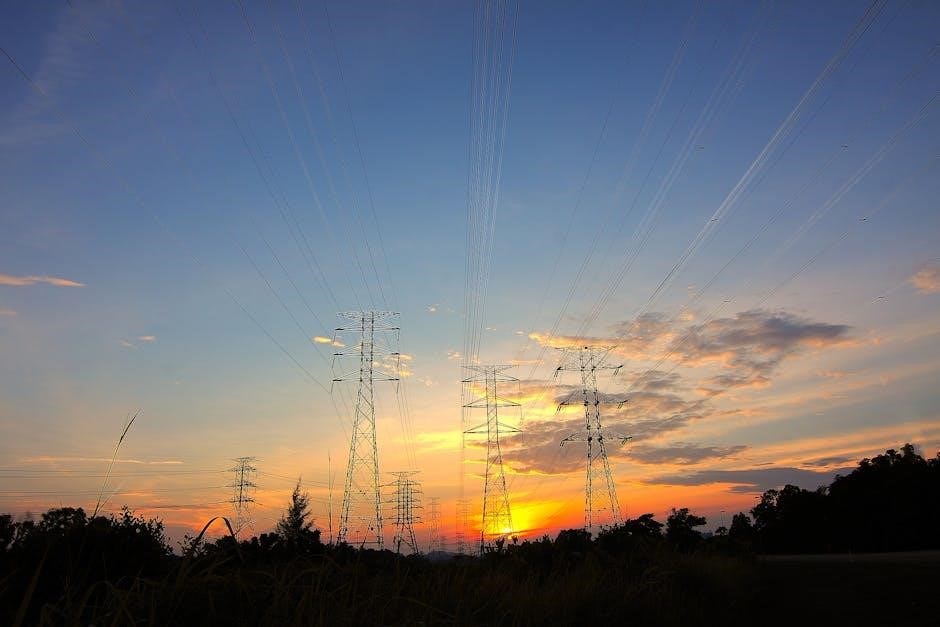Proper trailer wiring ensures safety and connectivity between vehicles. Understanding connectors, color codes, and configurations is crucial. This guide provides a comprehensive overview for safe and legal trailer setup.
1.1 Importance of Proper Trailer Wiring
Proper trailer wiring is essential for safety and legal compliance. It ensures communication between the tow vehicle and trailer, powering brakes and lights. Improper wiring can lead to accidents, fines, or equipment damage. Correct connections guarantee all trailer lights function, enhancing visibility and road safety. Additionally, proper wiring prevents electrical overloads and corrosion, extending system lifespan. Many states enforce strict regulations, requiring trailers to meet specific wiring standards. Failure to comply may result in legal penalties. Proper wiring also ensures compatibility with your vehicle’s electrical system, avoiding potential damage. By prioritizing correct installation and maintenance, you protect yourself, others, and your equipment. Always follow guidelines to ensure reliability and adherence to federal and state requirements.
1.2 Common Mistakes to Avoid
When working on trailer wiring, several common mistakes can lead to safety hazards and functionality issues. One of the most frequent errors is using the wrong gauge wire, which can cause overheating or power loss. Another mistake is reversing the polarity of connectors, leading to malfunctioning lights or brakes. Neglecting to secure wires properly can result in damage from abrasion or moisture. Additionally, many individuals overlook the importance of regular inspections, allowing corrosion or wear to go unnoticed. Using incompatible connectors or adapters can also disrupt communication between the vehicle and trailer. Finally, some people skip testing the system after installation, which can lead to undiscovered faults. Avoiding these mistakes ensures reliable performance, safety, and compliance with regulations. Always double-check connections and seek professional help if unsure.
1.3 Overview of Trailer Wiring Systems
Trailer wiring systems are designed to establish communication and power transfer between a towing vehicle and a trailer. These systems typically consist of connectors, adapters, and wiring harnesses that ensure proper signal transmission. The most common configurations include 4-way, 5-way, and 7-way connectors, each catering to specific trailer types and functionalities. The 4-way system is basic, supporting turn signals and brake lights, while the 7-way adds connections for brakes, auxiliary power, and reverse lights. Adapters are often used to accommodate compatibility between different connector types. Wiring harnesses are tailored to vehicle and trailer specifications, ensuring seamless integration. Proper installation and regular maintenance are critical to prevent malfunctions. Troubleshooting tools, such as wiring diagrams, are essential for diagnosing issues. Understanding these systems is vital for safe towing operations and compliance with legal requirements. Always consult a professional if unsure about compatibility or installation.

Understanding Trailer Wiring Basics
Mastering trailer wiring involves knowing connectors, color codes, and essential tools. It ensures safe connections and proper communication between your vehicle and trailer, avoiding potential hazards on the road.
2.1 Essential Concepts of Electricity for Trailer Wiring
Understanding basic electrical principles is crucial for safe and effective trailer wiring. Voltage, current, and resistance are fundamental concepts. Voltage, or electrical pressure, drives current through a circuit. Resistance opposes this flow. Ohm’s Law (V=IR) explains their relationship. Circuits are pathways for electricity, classified as series or parallel. Series circuits have components in a single path, while parallel circuits allow multiple paths. Grounding is essential for safety, completing the circuit and preventing hazards. Fuses and circuit breakers protect against overcurrent. Correct wire gauge ensures minimal resistance and safe operation. Knowledge of polarity (positive/negative) is vital to avoid short circuits. Testing with multimeters ensures connections are secure and functioning. These concepts form the foundation for troubleshooting and installing trailer wiring systems safely and efficiently. Proper understanding helps prevent damage and ensures reliable operation of trailer lights and accessories. Always follow safety practices when working with electrical systems.
2.2 Types of Trailer Wiring Connectors
Trailer wiring connectors vary based on the number of pins, each serving specific functions. The 4-pin connector is the most common, supporting basic lighting functions like turn signals, brake lights, and running lights. A 5-pin connector adds a fifth wire for auxiliary power, often used for trailers with electric brakes. The 6-pin connector includes an additional wire for hydraulically actuated brakes, while the 7-pin connector adds a circuit for reverse lights. Heavy-duty applications may use round or oval connectors with more pins for advanced features. Adapters are available to connect mismatched plug types. Choose the connector that matches your vehicle and trailer needs for proper functionality. Always ensure the connector is clean and securely attached to maintain reliable electrical connections. Proper connector selection ensures safety and prevents electrical issues while towing.
2.3 Trailer Wiring Color Codes Explained
Trailer wiring color codes are standardized to ensure consistency and safety. The green wire typically controls the right turn signal and brake light, while the yellow wire handles the left turn signal and brake light. Brown wires are for running lights or taillights, providing constant power when the vehicle’s lights are on. Red wires often connect to the brake lights, activating when the vehicle’s brakes are applied. Blue wires are commonly used for auxiliary functions, such as electric brakes or reverse lights. Black wires usually serve as the 12V power source, while white wires are grounded to the trailer frame. Understanding these color codes is essential for proper wiring setup and ensures all lights function correctly. Always consult a wiring diagram specific to your vehicle and trailer for accurate connections to avoid electrical issues and ensure safe towing.
2.4 Tools and Materials Needed for Trailer Wiring
Successfully installing or repairing trailer wiring requires the right tools and materials. Essential tools include a wiring harness, connectors, a multi-meter for testing, wire cutters, and heat shrink tubing for insulation. Electrical tape and a crimping tool are also necessary for secure connections. A soldering iron can be useful for permanent fixes, while a test light helps identify live wires. Materials needed include assorted wire gauges, splice connectors, and a wiring diagram specific to your vehicle and trailer setup. For custom installations, a trailer wiring adapter or converter may be required. Having these tools and materials on hand ensures a safe and efficient wiring process. Proper preparation prevents delays and ensures all electrical systems function correctly. Always refer to your vehicle and trailer manuals for specific requirements.

Choosing the Right Trailer Wiring Setup
Choosing the right trailer wiring setup involves determining your vehicle’s towing capacity, ensuring compatibility with your trailer’s electrical system, and selecting the appropriate connectors for safe and reliable operation.
3.1 Determining the Correct Wiring Configuration for Your Vehicle
To determine the correct wiring configuration for your vehicle, start by consulting your vehicle’s manual to identify the factory wiring system. Use a wiring diagram specific to your vehicle make and model to understand the existing circuitry. Consider the type of trailer you will be towing, as different trailers require different wiring setups. For example, a basic trailer with lights may only need a 4-pin connector, while a trailer with brakes or additional accessories may require a 7-pin connector. Ensure compatibility between your vehicle’s towing package and the trailer’s electrical system. If your vehicle does not have a factory tow package, you may need to install an aftermarket wiring harness. Always verify the wiring configuration with a test light before connecting the trailer to ensure proper function and safety.
3.2 Custom Wiring vs. Splice-In Wiring: Pros and Cons
Custom wiring offers a tailored solution for your vehicle and trailer, providing reliability and optimal performance. It supports complex electrical demands, such as brakes and auxiliary lights, but can be costly and harder to repair. Splice-in wiring is a cost-effective, DIY-friendly option that uses existing vehicle wiring, making it quicker to install. However, it risks electrical issues and may lack durability. Custom wiring is ideal for long-term use, while splice-in suits temporary or simple setups. Choose based on your needs for cost, ease, and reliability.
3.3 Troubleshooting Common Trailer Wiring Issues
Identifying and resolving trailer wiring problems is essential for safe towing. Common issues include faulty connections, blown fuses, or incorrect wiring configurations. Start by inspecting connectors for corrosion or damage and ensure all plugs are securely attached; Use a multimeter to test voltage and continuity in the wiring circuit. If lights malfunction, verify the color coding matches the vehicle and trailer systems. A test lamp can help trace power flow. Consult a wiring diagram to pinpoint issues. Addressing problems promptly prevents further damage and ensures reliable operation. Regular maintenance and testing are key to avoiding delays and hazards on the road.

Installation and Safety Guidelines
Proper installation ensures safety and functionality. Always check connections, use a test lamp, and follow guidelines to avoid hazards. Safety practices prevent accidents and ensure reliable trailer operation.
4.1 Step-by-Step Guide to Installing Trailer Wiring
Begin by gathering tools like a test lamp, wire strippers, and connectors. Start at the vehicle’s wiring harness, identifying each wire using the color code guide. Connect the ground wire to a clean metal surface on the trailer frame. Next, attach the taillight wires to the trailer’s lighting system, ensuring correct polarity. Use a test lamp to verify each connection. For the brake wire, connect it to the trailer’s brake controller, ensuring proper functionality. Finally, secure all wires with zip ties or clips to prevent damage. Always double-check connections and test all lights before towing to ensure safety and compliance with regulations.
4.2 Safety Practices When Working with Electrical Systems
Always disconnect the power source before starting work on trailer wiring to prevent shocks or short circuits. Use a test lamp to verify de-energized circuits. Insulate all wire connections properly to avoid moisture damage. Avoid overloading the system with too many accessories. Wear protective gloves and safety glasses when handling electrical components. Ensure all tools are rated for the task. Never touch bare wires with bare hands. Keep flammable materials away from work areas. Regularly inspect wires for damage or corrosion. Use appropriate gauge wires to handle the current load. Follow manufacturer guidelines for connectors and fuses. Grounding systems correctly is critical for safety. If unsure, consult a professional. Always test the system thoroughly before use to ensure proper function and safety.
4.3 Importance of Testing Trailer Lights Before Use
Testing trailer lights is crucial for ensuring safety on the road. Properly functioning lights communicate your intentions to other drivers, reducing the risk of accidents. Before each use, check brake lights, turn signals, and running lights to confirm they are working. Use a test lamp or have someone observe the lights while you operate them. Faulty connections or damaged wires can lead to failed lights, which may result in legal penalties or dangerous situations. Regular testing helps identify issues early, allowing for timely repairs. Always ensure all lights are synchronized with your vehicle’s signals for clear communication. Testing also verifies that the wiring harness is functioning correctly, preventing potential electrical failures. Make it a routine practice to test trailer lights before every trip to ensure safe and legal operation of your trailer.

Maintenance and Repair of Trailer Wiring
Regular inspection and prompt repairs are vital for maintaining trailer wiring. Protect wires from damage and corrosion to ensure reliable performance and safety.
5.1 Regular Inspection of Trailer Wiring Components
Regular inspection of trailer wiring components is essential to ensure safety and reliability. Start by examining the connectors for signs of corrosion or damage, as these can disrupt electrical connections. Check the wiring harness for any physical damage, such as cuts, frays, or abrasions, which can expose wires and lead to shorts. Verify that all connections are secure and properly attached to the vehicle and trailer. Test the trailer lights to ensure they are functioning correctly, including brake lights, turn signals, and running lights. Inspect the ground wires to confirm they are clean and free of rust, as a poor ground can cause lighting issues. Finally, protect the wiring from environmental factors like moisture and extreme temperatures, which can degrade the system over time; Regular maintenance helps prevent failures and ensures safe towing operations.
5.2 Repairing Damaged or Corroded Trailer Wiring
Repairing damaged or corroded trailer wiring requires careful inspection and precise action. Begin by identifying the source of the damage or corrosion. For minor issues, such as frayed wires, strip the damaged section and splice in new wire, securing it with heat shrink tubing. Corroded connectors can be cleaned with a wire brush and treated with a rust-inhibiting spray. If connectors are severely damaged, replace them entirely. For more extensive damage, such as a broken wiring harness, trace the circuit to locate the fault and replace the affected section. Always test the wiring after repairs to ensure proper functionality. Regular maintenance and prompt repairs can prevent further deterioration and ensure reliable trailer operation. Proper tools, such as a multimeter, can aid in diagnosing electrical issues. Always follow safety guidelines when working with electrical systems to avoid accidents.
5.3 Upgrading Trailer Wiring for Enhanced Performance
Upgrading trailer wiring enhances reliability, safety, and functionality. Consider switching to higher-quality connectors with corrosion-resistant materials for better durability. LED lights are a popular upgrade, offering brighter illumination and lower power consumption. Installing a wiring harness with built-in surge protection can shield against electrical spikes. For advanced setups, integrate smart systems that monitor trailer functions like brakes and lights. Heavy-duty wiring is recommended for high-power applications, ensuring stable current flow. When upgrading, ensure all components are compatible and meet legal standards. Consult a professional if unsure, as improper installation can lead to safety hazards. Regular testing post-upgrade is crucial to verify system performance. Upgrading trailer wiring not only improves efficiency but also enhances overall towing safety and convenience, making it a worthwhile investment for frequent users.

Legal and Regulatory Requirements
Adhering to federal and state regulations is crucial for trailer wiring. Ensure compliance with standards for connectors, lighting, and documentation to avoid penalties and ensure road safety.
6.1 Federal and State Regulations for Trailer Wiring
Federal and state regulations govern trailer wiring to ensure safety and uniformity. The Federal Motor Carrier Safety Administration (FMCSA) sets standards for trailer lighting and wiring systems. States may have additional requirements, such as specific connector types or lighting configurations. Compliance with these regulations is mandatory to avoid penalties. Documentation, such as certification for custom wiring setups, may be required. Regular inspections are often necessary to verify that trailer wiring meets legal standards. Non-compliance can result in fines or being prohibited from operating the trailer. Understanding both federal and state regulations is essential for legal and safe trailer operation. Always consult local DMV resources for specific requirements in your area to ensure full compliance and avoid legal issues.
6.2 Commercial Driver License (CDL) Requirements for Trailer Wiring
Commercial Driver License (CDL) requirements for trailer wiring involve ensuring compliance with federal and state regulations. CDL holders must verify that trailer wiring systems meet safety and legal standards. Pre-trip inspections are critical, requiring drivers to check for damaged wires, proper connections, and functional lighting. Failure to comply can result in penalties or safety hazards. CDL manuals emphasize the importance of understanding wiring configurations and troubleshooting common issues. Drivers must also ensure that trailer wiring aligns with their vehicle’s specific setup. While basic knowledge is required, complex wiring problems may necessitate professional assistance. Adhering to these requirements ensures safe and legal operation of trailers under CDL regulations.
6.3 Documentation and Compliance for Trailer Wiring
Proper documentation and compliance are essential for trailer wiring to ensure legal and safe operation. Federal and state regulations require trailers to meet specific wiring standards, including functional lighting and electrical connections. Drivers must maintain records of inspections, repairs, and upgrades to demonstrate compliance. Documentation should include details about wiring configurations, connector types, and any modifications made. Compliance involves adhering to standards for trailer lighting, brakes, and electrical systems. Regular inspections are mandatory to verify that all components function correctly. Non-compliance can result in fines, penalties, or even operational shutdowns. Keeping detailed records and following regulations helps avoid legal issues and ensures safety on the road. Always refer to local and federal guidelines for the most accurate and up-to-date requirements.

Advanced Trailer Wiring Topics
Explore advanced wiring techniques, including diagram interpretation, multi-trailer setups, and LED installations. These specialized methods enhance functionality and safety for complex towing configurations and modern lighting systems.
7.1 Understanding Trailer Wiring Diagrams
Trailer wiring diagrams are essential for installing and troubleshooting electrical systems. They provide a visual representation of wire connections, color codes, and component locations. By understanding these diagrams, you can identify faults and ensure proper connections between your vehicle and trailer. Start by familiarizing yourself with symbols and legends, which explain each wire’s function. Most diagrams use standard colors, such as green for brake lights and yellow for left turn signals. For complex setups, like multiple trailers or accessories, diagrams become crucial for maintaining organization. Always refer to manufacturer-specific diagrams for accuracy, as variations exist between vehicles and trailers. Practice interpreting diagrams to enhance your wiring skills and ensure safe, reliable connections.
7.2 Wiring for Multiple Trailers or Accessories
Wiring for multiple trailers or accessories adds complexity to your setup but is manageable with proper planning. Start by assessing the total power requirements to avoid overloading your vehicle’s electrical system. Use heavy-duty wiring connectors and adapters to ensure compatibility between different trailers or accessories. Consider installing a centralized junction box to organize wires and reduce clutter. For accessories like LED lights or braking systems, dedicate separate circuits to prevent interference. Always refer to wiring diagrams for clarity, and test each connection before use. Regular inspections and maintenance are crucial to ensure reliability. By designing a structured and organized wiring system, you can safely and efficiently manage multiple trailers or accessories, enhancing your towing experience.
7.3 Installing LED Lights for Trailers
Installing LED lights on your trailer enhances visibility and efficiency. Start by consulting your trailer’s wiring diagram to understand the existing setup. LED lights are energy-efficient and durable, making them ideal for trailers. Determine the specific locations for the LED lights, ensuring they provide adequate illumination and meet legal requirements. When replacing old lights, use the same mounting points for simplicity. For new installations, plan the layout carefully to ensure even lighting distribution.
Use appropriate wiring connectors and ensure all connections are secure and insulated to prevent short circuits. Consider adding a separate circuit for the LED lights to avoid overloading your trailer’s electrical system. After installation, test each light to ensure proper function. Regular maintenance, such as cleaning and inspecting wires, will extend the life of your LED lighting system. By following these steps, you can enjoy the benefits of LED lighting on your trailer, including improved safety and reduced power consumption.
Proper trailer wiring ensures safety, legality, and functionality. Always test lights before use, adhere to regulations, and follow best practices for a secure and efficient setup.
8.1 Summary of Key Trailer Wiring Concepts
Trailer wiring is essential for ensuring safe and reliable connections between vehicles and trailers. Properly installed systems prevent accidents and ensure compliance with legal standards. Key concepts include understanding wiring diagrams, color codes, and connector types. Safety practices, such as testing lights before use, are critical. Regular inspections and maintenance prevent corrosion and damage. Adherence to federal and state regulations guarantees legal operation. Upgrading to advanced systems, like LED lighting, enhances performance and visibility. Always consult diagrams and manuals for specific configurations. Proper tools and materials, such as splice connectors and test lamps, simplify installations. Troubleshooting common issues, like faulty ground connections, ensures smooth operation. By following these guidelines, drivers can ensure secure, efficient, and legal trailer setups.
8.2 Final Tips for Safe and Effective Trailer Wiring
Always test trailer lights before use to ensure functionality. Regularly inspect wiring for damage or corrosion and address issues promptly. Use high-quality materials and tools to maintain reliability. Ground wires correctly to prevent signal interference. Keep connections secure and protected from environmental factors. Follow wiring diagrams and manufacturer guidelines for precise installations. Prioritize safety by adhering to local regulations and standards. Consider upgrading to LED lights for improved visibility and durability. Use the correct connector types for your vehicle and trailer setup. Avoid overloading circuits to prevent electrical failures. Label wires for easier maintenance and troubleshooting. By following these tips, you can ensure safe, efficient, and legal trailer wiring, enhancing both performance and peace of mind while on the road.
